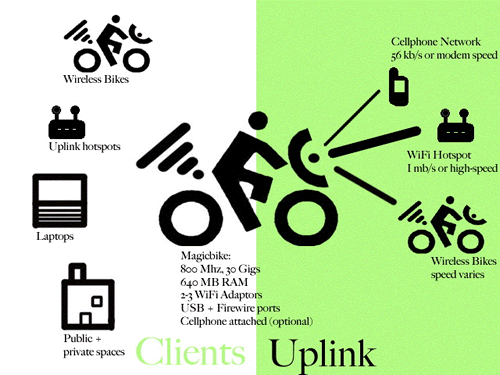|
magicbike is a mobile WiFi (wireless Internet) hotspot that gives free Internet connectivity wherever its ridden or parked. By turning a common bicycle into a wireless hotspot, Magicbike explores new delivery and use strategies for wireless networks and modern-day urbanites. Wireless bicycles disappear into the urban fabric and bring Internet to yet unserved spaces and communities. Mixing public art with techno-activism, Magicbikes are perfect for setting up adhoc Internet connectivity for art and culture events, emergency access, public demonstrations, and communities on the struggling end of the digital-divide. Weaving Internet Infrastuctures into Cultural Fabric Magicbike aims to weave wireless infrastructures into an existing mobile and socially active cultural fabric, bicycle culture. Bicycles are extremely versatile vehicles that travel many places inaccessible by automobiles and other forms of transportation. Bicycles are also traditional symbols of political movements ranging from the women’s movement in the latter 19th century, to the labor movements of the early 20th century, through today where bicycles are held in high esteem as a clean, energy-efficient alternative to a global dependence on oil and urban sprawl. Since WiFi is an emerging technology based on open standards it is malleable. Superimposing WiFi technology onto bicycle culture pushes the technology towards the particular needs, tastes, and motivations of bicyclists. Wireless and computing technology gain from becoming more (mobile and) bicycle and street friendly. The culture around wireless is also influenced by century-old cultural trends of political consciousness, social responsibility, and physical health. Bicycle Hotspots Tech Description Magicbike turns common bicycles into WiFi hotspots. The end effect creates bicycles that broadcast free WiFi connectivity to their proximity. The technology behind this is not complex. Magicbike is simply a creative configuration, or reconfiguration, of widely available computer, bicycle, and WiFi gear. WiFi antennas mounted on the bike's frame feed into a laptop embedded into a specially outfitted bicycle side-bag. The bike's embedded laptop is configured to be a wireless repeater and hotspot. The bike receives its uplink connection either from the cellular network or from far-off WiFi hotspots (with the help of its mounted antennas). With this uplink connection from any one of various sources, the bike is able to serve-up its own Internet connection.
A Magicbike hotspot operates like standard hotspots, able to serve up to 250 users in a radius of 30 meters indoors and 100 meters outdoors [although its antennas can increase the hotspot’s accuracy and range]. A group of bikes can repeat and/or bridge the signal down a chain of wireless bikes. Meaning, a bicycle gang can snake into subways stations or across hilltops to provide Internet connectivity to (fringe but) vital communities and spaces ignored by the traditional telecommunications industry. A grassroots bottom-up wireless infrastructure can be formed and pedaled to any place accessible by bicycle. Wireless Bikes as Art Objects Wireless bikes are a tacitly surrealistic Ready-made that playfully reframe our assumptions about the interplay of technology and art. The tradition of Ready-made objects in modern art is credited to start with Marcel Duchamp’s “Roue de Bicyclette” or “Bicycle Wheel,” his first “Ready-made.” The bicycle’s role in art seems to be that of a transcendent object acting as a vehicle to interface conceptual and material existence, virtual and real existence, if you will. At first, “wireless bikes” seem like an incongruous montage and technological farce. But, importantly, this technological farce out performs the market in providing Internet access to vital urban spaces. As art out-maneuvers commerce, we see that our technological boundaries are products of our imagination and not truly technological at all. Riding down the streets or parked, these bikes become beacons for play and inquiry. They ignite our imagination about the boundaries of bike and computer, mundane and hi-tech, street protest and online activism, mediated play and spectacle. Artist Bio Yury Gitman is a wireless and emerging-media artist. He engages WiFi, web development, hardware hacking, and the culture around wireless to create expressive pieces and art interventions. He has exhibited work with Eyebeam and The New Museum among many others. Noderunner, a wireless game he co-created was awarded the Ars Electronica Golden Nica for Net Vision in 2003. The New York Daily News, credited him for creating two of the top ten "hippest hotspots" in New York, Magicbike (the bicycle hotspot) and EVill Net (the East Village network). Currently he teaches a graduate level Wireless Art course at the Parsons School of Design. Additionally, he is the director of the Arts group at NYCWireless. He received a Masters degree from New York University's Interactive Telecommunication Program and a BS in Science, Technology, and Culture from the Georgia Institute of Technology. |
